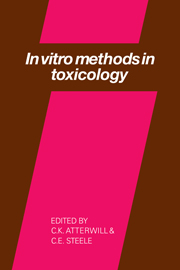Book contents
- Frontmatter
- Contents
- List of contributors
- Preface
- Introduction
- TARGET ORGAN TOXICITY
- In vitro methods in renal toxicology
- Ototoxicity
- Cultured cell models for studying problems in cardiac toxicology
- Use of the isolated rat heart for the detection of cardiotoxic agents
- Brain reaggregate cultures in neurotoxicological investigations
- Application of thryoid cell culture to the study of thyrotoxicity
- In vitro methods to investigate toxic lung disease
- Metabolism and toxicity of drugs in mammalian hepatocyte culture
- In vitro evaluation of haemic systems in toxicology
- GENERAL AND TOPICAL TOXICITY
- REPRODUCTIVE TOXICITY
- CONCLUSION
- Index
In vitro methods to investigate toxic lung disease
Published online by Cambridge University Press: 06 August 2010
- Frontmatter
- Contents
- List of contributors
- Preface
- Introduction
- TARGET ORGAN TOXICITY
- In vitro methods in renal toxicology
- Ototoxicity
- Cultured cell models for studying problems in cardiac toxicology
- Use of the isolated rat heart for the detection of cardiotoxic agents
- Brain reaggregate cultures in neurotoxicological investigations
- Application of thryoid cell culture to the study of thyrotoxicity
- In vitro methods to investigate toxic lung disease
- Metabolism and toxicity of drugs in mammalian hepatocyte culture
- In vitro evaluation of haemic systems in toxicology
- GENERAL AND TOPICAL TOXICITY
- REPRODUCTIVE TOXICITY
- CONCLUSION
- Index
Summary
INTRODUCTION
The lungs are a major route of entry Into the body and as such are constantly exposed either inadvertantly or (as in the case of tobacco smoke) deliberately to a wide range of toxic materials. Some toxicological changes result not from an agent being innately or specifically toxic to the lung but simply because lung cells are the first target encountered. Some materials may then become trapped and accumulate in the respiratory tract. Other substances, such as paraquat and 4-ipomeanol, apparently demonstrate a selective toxicity for specific target cells in the lung. This latter type of lung toxicity may occur even if the route of entry into the body is by a non-pulmonary route.
In addition to respiration the lung is involved in the synthesis, release and removal from the circulation of various mediators such as the prostaglandins and kinins. Insult to the lung is capable of perturbing any of these pulmonary functions. In clinical practice radiography and tests of respiratory function are the usual methods used to assess the structural and functional state of the lungs. For this reason alterations in lung function are rarely detected before the pulmonary architecture is damaged sufficiently to affect x-ray appearance or gas exchange. However, even these classical methods of detecting lung damage in humans are not widely available for use with experimental animals.
- Type
- Chapter
- Information
- In Vitro Methods in Toxicology , pp. 189 - 210Publisher: Cambridge University PressPrint publication year: 1987
- 1
- Cited by



